 | |
| Overview | |
|---|---|
| Maker | Panasonic Holdings Corporation |
| Type | Digital Camera |
| Lens | |
| Lens | f=4.7 - 17.7mm (24 - 90mm in 35mm equiv.) F1.4/2.3 |
| Sensor/medium | |
| Sensor | 1/1.7" MOS res = 3648×2736 (10.1 megapixels) |
| Film speed | ISO 80, 100, 200, 400, 800, 1600, 3200, High Sensitivity (1600 - 12800) |
| Storage media | Built-In Memory appx 70Mb + (Secure Digital Card (SD/SDHC/SDXC) |
| Focusing | |
| Focus modes | Normal / Macro, Quick AF, Continuous AF, AF / MF Switchable, Manual Focus (Jog dial), One Shot AF, AF Area Select, AF Tracking |
| Focus areas | Face, AF Tracking, Multi (23-area), 1-area (flexible / scalable) |
| Exposure/metering | |
| Exposure modes | Program AE, Aperture Priority AE, Shutter Priority AE, Manual, Program Shift (Program AE Mode), Creative Mode, Creative Video Mode, Custom Mode 1, Custom Mode 2, Scene Mode, Intelligent Auto |
| Metering modes | Intelligent Multiple, Center Weighted, Spot |
| Flash | |
| Flash | Internal |
| Shutter | |
| Shutter speed range | 1/4000 sec – appx 250 sec |
| Continuous shooting | 11 fps for 12 frames (Fine), up to approx. 60 frames/sec (recorded in 2.5M) / approx. 40 frames/sec (recorded in 5M) |
| Image processing | |
| White balance | Auto, Daylight, Cloudy, Shade, Flash, Halogen, Color Temperature, White Set 1, White Set 2, White Balance Adjustment |
| General | |
| LCD screen | 7.5cm(3.0") TFT Screen LCD Display (920K dots) |
| Battery | Li-ion Battery Pack (3.6 V, 1250 mAh) |
| Dimensions | 109.7×65.5×43.0 mm (4.32×2.58×1.69 in) (W * H * D) |
| Weight | 271 g (9.6 oz) |
| Made in | |
The Panasonic Lumix DMC-LX7, or LX7, is a high-end compact "point and shoot" camera launched by Panasonic in 2012 to succeed the LX5.